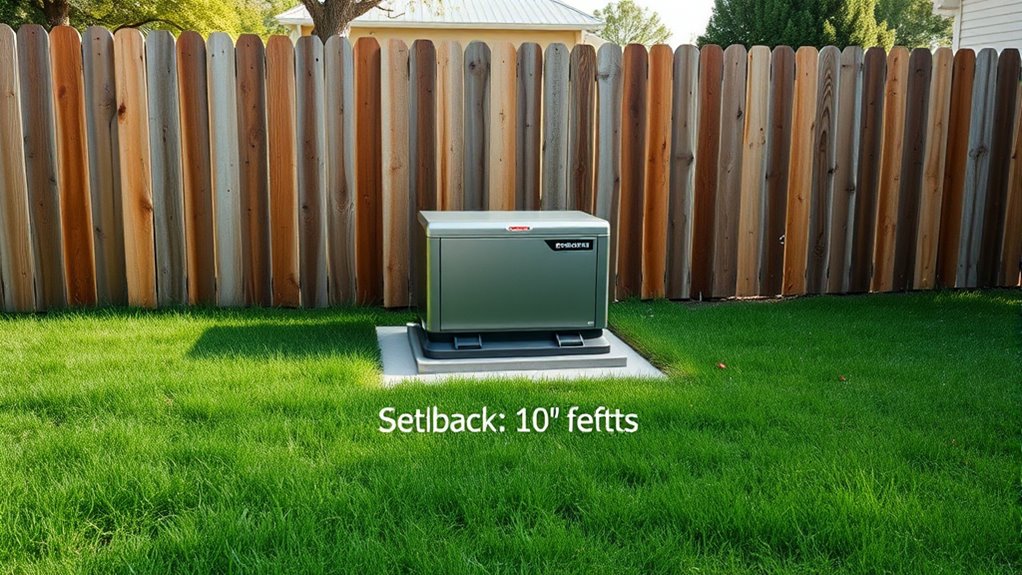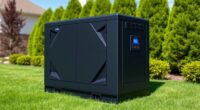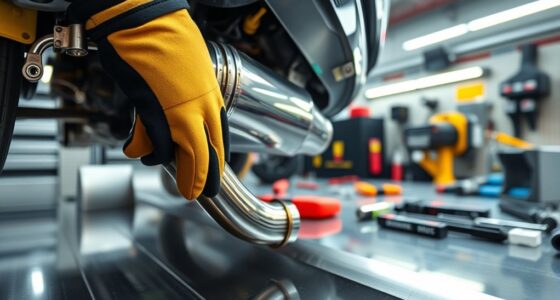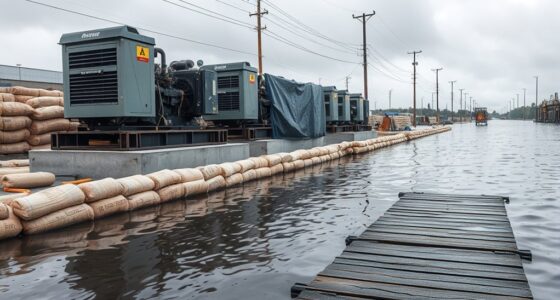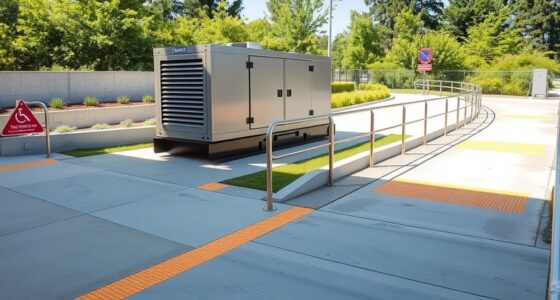To safely install a generator, start by checking local regulations and building codes for setback distances, noise limits, and permits. Choose a flat, ventilated spot away from windows, vents, and combustible materials, ideally on a concrete pad. Keep it protected from weather, and make certain proper exhaust and ventilation. Use a transfer switch for safe electrical connection. Proper placement and ongoing maintenance make your setup safe and reliable—continue exploring to learn all the essential steps.
Key Takeaways
- Understand local regulations, codes, and setback requirements to ensure safe and compliant generator placement.
- Choose a level, stable site with proper ventilation, minimizing noise and exhaust exposure.
- Maintain recommended setbacks from windows, vents, and combustible materials to prevent fire hazards and fumes.
- Use a transfer switch for safe electrical connections and proper power transfer to your home.
- Regularly inspect, maintain, and shield the generator for optimal safety, performance, and longevity.
Understanding Local Regulations and Codes
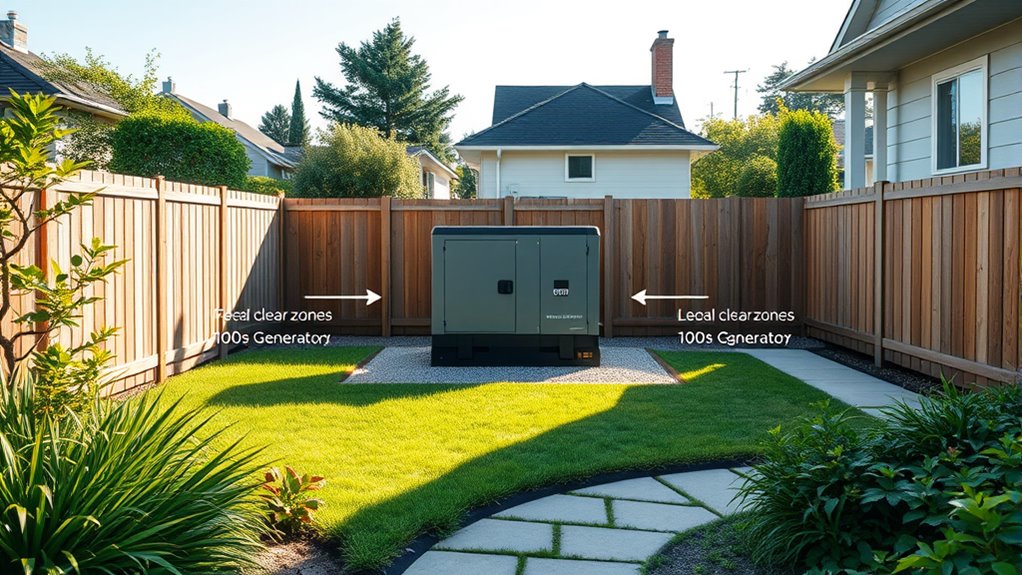
Understanding local regulations and codes is vital before installing a generator, as these rules determine where and how you can place your unit. Zoning restrictions might limit the types of equipment allowed in your area or specify setback distances from property lines. Noise ordinances also play an important role, as they restrict how loud your generator can be, especially during certain hours. Ignoring these regulations can lead to fines or having to relocate your generator later. You should check with your local building department or city ordinances to understand specific requirements. Complying with these rules ensures your generator operates legally and safely, preventing potential disputes with neighbors and avoiding costly modifications down the line. Additionally, researching trending genres can help tailor your setup to appeal to a broader audience, boosting your success.
Choosing the Right Location for Your Generator
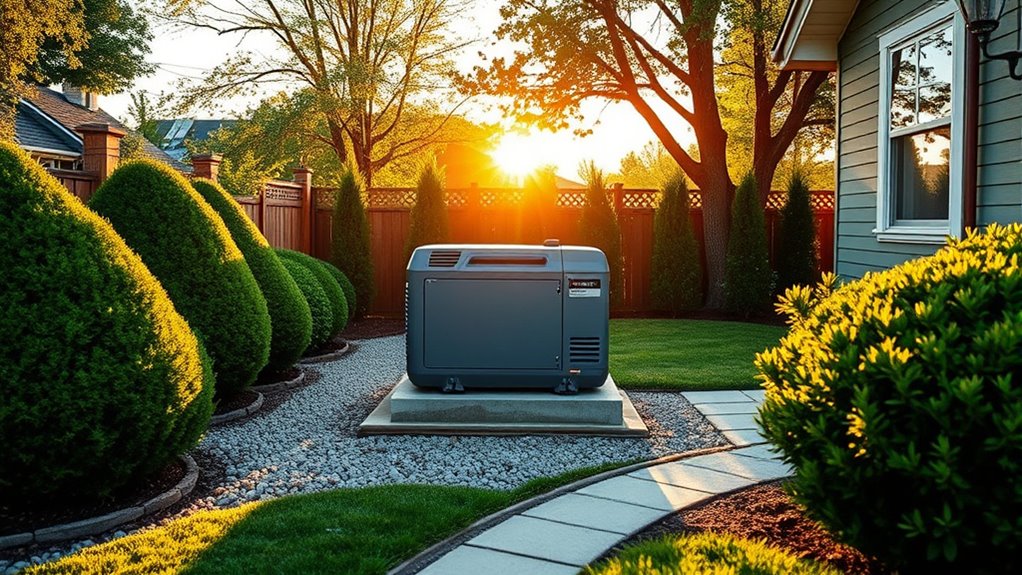
Selecting the ideal spot for your generator is crucial to guarantee safety, efficiency, and compliance with regulations. To do this effectively, consider these key points:
- Generator size – make certain the location can accommodate your generator’s dimensions without obstruction.
- Fuel type – choose a well-ventilated area suited for your fuel source, such as propane or gasoline.
- Ventilation and noise – position it where exhaust fumes won’t pose risks and noise won’t disturb your household or neighbors.
- Understanding safety protocols – ensure the site adheres to recommended conflict resolution skills, promoting a safe environment for operation.
Factors to Consider When Positioning Your Generator

When positioning your generator, several practical factors influence its safety and functionality. First, consider the generator size; a larger unit may require a more spacious, well-ventilated spot to prevent overheating. Also, your fuel type plays a crucial role—gasoline generators need good airflow and protection from rain, while propane models might be more versatile but still require proper ventilation. Confirm the location is accessible for refueling and maintenance. Avoid enclosed or confined spaces to reduce the risk of carbon monoxide buildup. Think about noise levels and how to minimize disturbance to your household and neighbors. Finally, choose a spot that’s level and stable, preventing vibrations or movement that could damage the unit or affect its operation. Proper ventilation is essential for safe generator operation and to prevent hazardous fumes from accumulating.
Proper Setback Distances and Why They Matter

Knowing the proper setback distances is essential to stay compliant with safety and fire codes. These distances also influence noise levels and guarantee proper ventilation for your generator. Ignoring local regulations and permit requirements can lead to costly issues down the line. Additionally, understanding the best placement techniques can help optimize soundproofing and reduce disturbance to surrounding areas. Soundproofing techniques are crucial for maintaining good neighbor relations and ensuring your generator operates efficiently.
Safety and Fire Codes
Proper setback distances are essential for guaranteeing safety and compliance with fire codes when placing a generator. Maintaining the correct distance helps prevent fire hazards, especially related to fuel safety and fire prevention. If the generator is too close to your home or other structures, it increases the risk of fire spreading and carbon monoxide buildup. To stay compliant, consider these key points:
- Follow local fire code requirements for setback distances.
- Keep the generator away from windows, vents, and combustible materials.
- Ensure proper ventilation to avoid dangerous exhaust buildup.
- Understanding generator placement best practices can help ensure safety and code compliance.
Noise and Ventilation Needs
To minimize noise disturbances and guarantee adequate ventilation, maintaining proper setback distances for your generator is essential. Sound levels can be disruptive if the generator is placed too close to living spaces or neighboring properties. Keeping your generator at an appropriate distance helps reduce noise transmission and keeps your environment comfortable. Additionally, ventilation requirements are critical to prevent dangerous buildup of exhaust gases and ensure proper airflow. Placing your generator too near structures can hinder ventilation and increase fire risks. By adhering to recommended setbacks, you protect your home from excessive noise and ensure safe operation through proper airflow. Proper placement balances noise control and ventilation needs, creating a safer, quieter environment for you and your neighbors. Understanding projector technology can also help you choose the right setup for your space and needs.
Local Regulations and Permits
Local regulations and permits establish critical requirements for setback distances when installing a generator, ensuring safety and compliance. These rules prevent hazards, reduce noise disruptions, and limit environmental impact. Ignoring them can lead to fines, increased utility billing costs, or safety hazards. To understand the importance, consider these points:
- Proper setbacks protect neighbors from noise and exhaust fumes.
- They help minimize environmental impact by controlling emissions and preventing pollution.
- Regulations often specify minimum distances to avoid issues with utility billing, such as interference with power lines.
- Adhering to these rules also supports well-being by maintaining a safe and healthy environment for all community members.
Establishing proper setbacks not only complies with legal standards but also promotes overall health and safety for you and your neighbors.
Ensuring Adequate Ventilation and Exhaust Safety
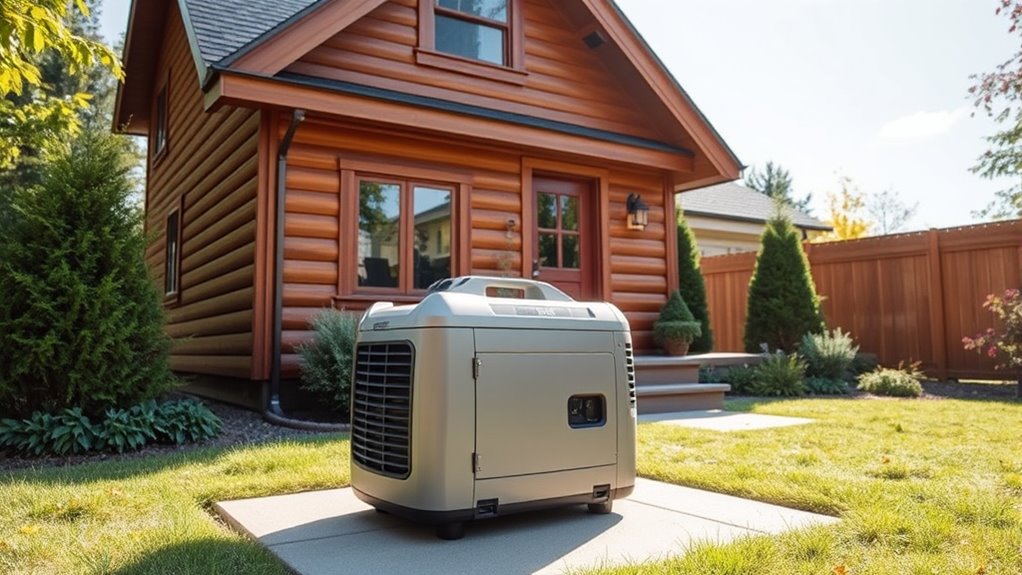
Ensuring adequate ventilation and exhaust safety is crucial when installing a generator to prevent dangerous buildup of carbon monoxide and other fumes. You must follow ventilation requirements closely to guarantee fresh air circulation and proper exhaust dispersal. Place your generator in a well-ventilated outdoor area, avoiding enclosed spaces or tight corners where fumes can accumulate. Use exhaust extensions if necessary to direct fumes away from windows, doors, and vents. Regularly inspect exhaust systems for leaks or blockages to maintain exhaust safety. Proper ventilation not only reduces health risks but also helps your generator operate efficiently. Additionally, understanding the best heat pump features can aid in selecting systems that are more efficient and reliable, reducing the likelihood of operational issues. Remember, inadequate exhaust safety measures can lead to carbon monoxide poisoning, so prioritize proper placement and ongoing maintenance for safe generator operation.
Protecting Your Generator From Weather and Elements
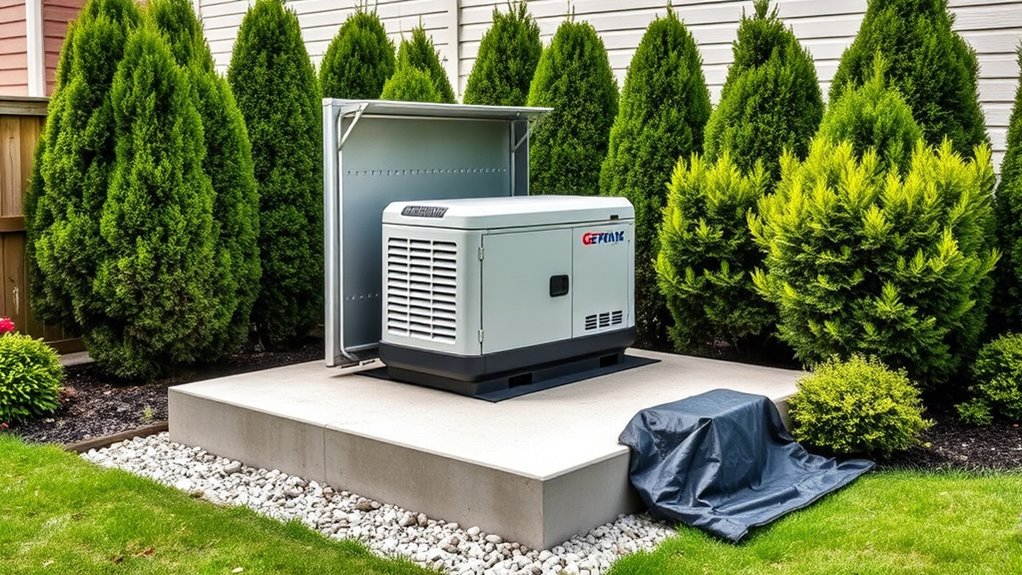
Protecting your generator from weather and the elements is essential to guarantee its reliable performance and longevity. Proper weather protection helps prevent damage caused by rain, snow, or extreme sunlight, ensuring your generator stays operational when you need it most. To achieve effective element shielding, consider these steps:
Shield your generator from the elements to ensure reliable performance and long-term durability.
- Install a weather-resistant cover or enclosure that shields against rain, snow, and debris.
- Elevate your generator on a concrete pad to prevent flooding and moisture exposure.
- Use vented enclosures to allow proper airflow while offering protection from the elements.
Connecting Your Generator Safely and Effectively
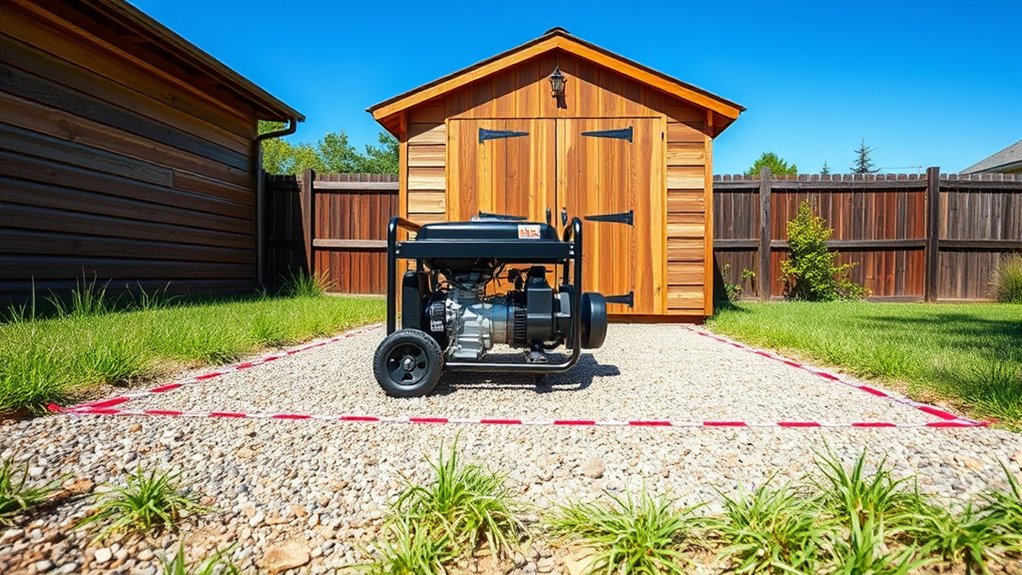
Connecting your generator correctly is vital for safety and efficiency. You need to follow proper techniques to prevent electrical hazards and guarantee a reliable power supply. Using a transfer switch is highly recommended to make the connection seamless and safe. Ensuring your generator’s placement accounts for forsale 100 options to optimize space and accessibility.
Proper Connection Techniques
Proper connection techniques are essential for safely and effectively powering your home with a generator. Ensuring proper connection safety prevents electrical hazards and protects your equipment. Here are key wiring techniques to contemplate:
- Use a transfer switch to safely isolate your home’s wiring from the grid.
- Follow manufacturer instructions for wiring connections, avoiding shortcuts.
- Inspect all cables and connectors for damage before plugging in.
- Ensure the bedroom design includes accessible and clearly labeled electrical outlets to facilitate safe and proper generator connections.
Preventing Electrical Hazards
Safely connecting your generator requires careful attention to electrical hazards that can cause shock, fire, or damage. Start by following proper grounding procedures to prevent electrical shock and ensure safe operation. Proper grounding involves connecting the generator to a grounding rod or grounding system, reducing the risk of stray voltage and static buildup. Always inspect your cords and connections for damage before use. Keep the generator away from wet areas and never touch live wires or outlets during operation. Use grounded extension cords rated for your generator’s load to avoid overloads. By adhering to these safety measures, you minimize the risk of electrical shock and fire, protecting yourself and your property while ensuring your generator runs efficiently and safely.
Using Transfer Switches
To guarantee your generator powers your home safely and efficiently, using a transfer switch is essential. This device disconnects your home’s electrical system from the utility, preventing backfeed and ensuring generator transfer safety. Proper transfer switch installation is critical for safe operation and compliance with electrical codes. When connecting your generator, follow these steps:
- Hire a licensed electrician for professional transfer switch installation.
- Ensure the switch is rated for your generator’s wattage.
- Test the transfer switch regularly for proper functionality.
Using a transfer switch minimizes the risk of electrical hazards, protects utility workers, and provides seamless power transfer during outages. Remember, always prioritize generator transfer safety by following manufacturer instructions and local regulations.
Regular Maintenance and Monitoring of Placement Conditions

Regular maintenance and monitoring are essential to guarantee your generator remains in prime condition and continues to operate safely within its designated placement. By regularly checking for debris, corrosion, and proper ventilation, you ensure peak performance. Monitoring fuel efficiency helps identify potential issues early, saving you money and preventing breakdowns. Remote monitoring tools allow you to track your generator’s status from anywhere, providing real-time alerts for maintenance needs or performance drops. Keeping the placement area clear of obstructions maintains proper airflow and reduces safety hazards. Consistent inspections and timely servicing extend your generator’s lifespan and ensure it’s ready when you need it most. Staying proactive with maintenance and monitoring safeguards your investment and guarantees reliable power during outages.
Frequently Asked Questions
How Do Noise Regulations Impact Generator Placement Choices?
Noise regulations influence where you place your generator because you need to take into account sound barriers and zoning laws. These rules often require you to position your generator away from neighbors and use sound barriers to reduce noise pollution. Zoning laws may restrict generator placement in certain areas, so you’ll want to check local regulations first. Proper placement ensures you stay compliant and minimize noise disturbance for everyone nearby.
Can Landscape Features Influence Optimal Generator Positioning?
Sure, your garden’s aesthetics and wildlife considerations do influence your generator’s placement. You might think hiding it behind that lush shrubbery or near the birdbath adds charm, but remember, noisy generators aren’t exactly nature’s lullaby. Strategic placement amidst landscape features helps minimize visual impact and preserves local wildlife. Just don’t hide it so well that you forget where it is—otherwise, you’ll be searching in the dark when the power’s out!
What Are the Best Materials for Protecting Generators Outdoors?
You should use durable materials like heavy-duty plastic or metal for protecting generators outdoors. These materials resist weather, rust, and corrosion, ensuring your generator fuels stay safe. Adding a protective cover made from waterproof fabric or vented plastic further shields your unit from rain, debris, and pests. Combining sturdy materials with protective covers keeps your generator secure and operational, regardless of outdoor conditions.
How Does Proximity to Trees Affect Generator Safety and Operation?
Picture a sturdy generator standing near towering trees. Too close, and you risk falling branches or debris damaging it, compromising safety and operation. Maintaining proper tree clearance guarantees wind protection while preventing obstructions. Keep your generator a safe distance from trees to avoid interference during storms or high winds. This way, you protect your equipment and ensure smooth operation, even when nature throws a storm your way.
Are There Specific Setbacks for Different Types of Generators?
Yes, setbacks vary based on generator size and fuel type. Larger generators require more space to guarantee safety and proper ventilation, while smaller models need less distance. Gas-powered units often need greater setbacks due to exhaust fumes, whereas inverter generators may have smaller requirements. Always follow manufacturer recommendations and local codes, making certain your generator is placed at a safe distance to prevent fire hazards, carbon monoxide buildup, and noise issues.
Conclusion
By following these guidelines, you’ll guarantee your generator stands strong like a fortress, ready to power your home when needed. Just as a wise captain carefully charts their course, proper placement and setbacks keep you safe and your generator running smoothly. Remember, attention to detail now prevents turbulence later. Stay vigilant, respect the rules, and your generator will serve you faithfully, much like a trusty steed ready to carry you through any storm.
